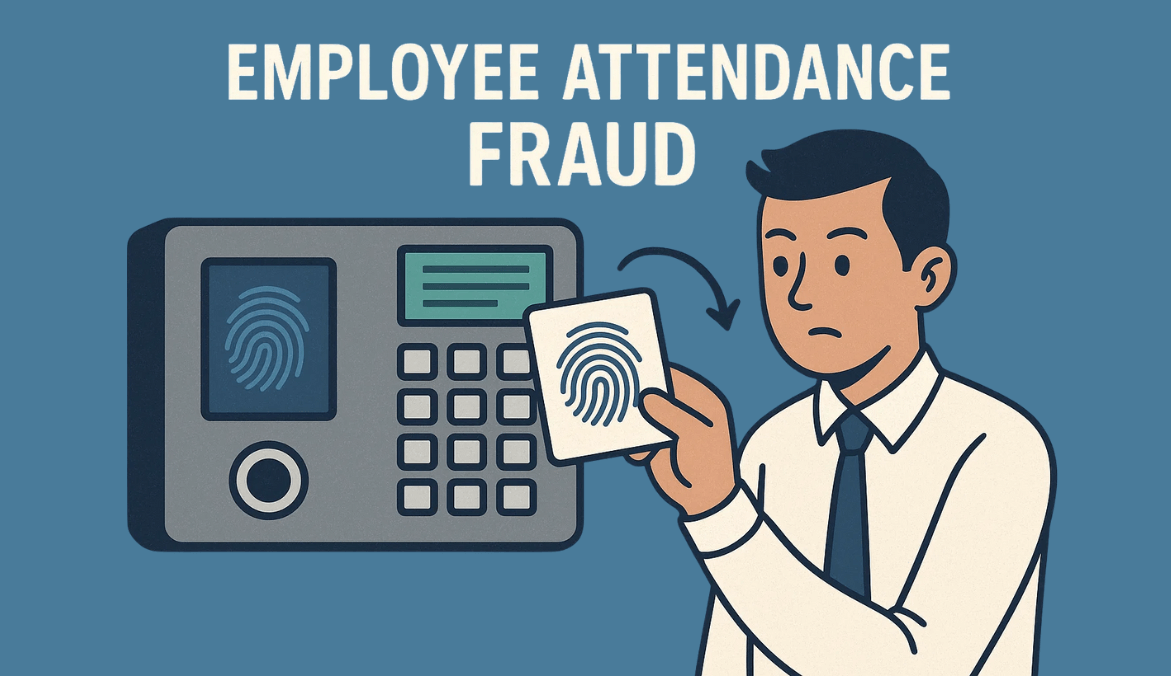Introduction
If you’ve ever caught yourself wondering whether all those timesheets, punches, or check-ins are truly accurate, you’re not alone. Employee attendance fraud—whether it’s buddy punching, ghost employees, or creative time theft—is one of the quietest drains on a company’s resources.
Over a decade of working with organizations from global enterprises to fast-scaling startups, I’ve seen this problem take many forms. The good news? With the right mix of policy, process, technology, and trust-building, you can prevent it without turning your workplace into a surveillance state. This guide expands on the root causes, real-world fraud patterns, and practical steps you can take to prevent them.
What Counts as Attendance Fraud (and Why It’s Rising)
Attendance fraud isn’t just about someone sneaking out early. It comes in many flavors:
- Buddy punching: a co-worker clocks in for someone else.
- Ghost employees: names on payroll who don’t actually work.
- Off-site clock-ins: logging time while nowhere near the workplace.
- Timesheet padding: editing or rounding up hours.
Quick reality check: About 24% of workers overreport or manipulate their hours, resulting in an average of 4.5 hours per week of stolen time—making time theft one of the most common forms of workplace fraud.
Why it’s rising: Hybrid setups, multi-site operations, and legacy manual systems create gaps. When policies are unclear and systems don’t sync, it becomes easier for fraud to slip through the cracks. In one compliance audit I supported, payroll discrepancies worth thousands of dollars went unnoticed for six months simply because the HRIS and payroll software weren’t integrated.
Fast wins you can deploy this week:
- Start requiring employees to acknowledge shifts or schedules.
- Run a simple reconciliation between payroll and HRIS records.
- Create a “missed punches” report and fix anomalies daily—not monthly.
The Fraud Patterns You’ll Actually See
Buddy Punching
This is the classic—one employee clocks in for another. It’s especially common in offices with shared kiosks or swipe cards.
Action step: Introduce device binding (each employee must use their own device) or optional photo prompts with consent.
Research from the U.S. Bureau of Labor Statistics shows that there are more than 78 million hourly workers in the U.S. If 16% of them clock in for a coworker through buddy punching, it could add more than $373 million to the annual payroll bill. While it might seem small per incident, these hidden losses quickly mount across a workforce, making buddy punching a significant drain on company resources.
Ghost Employees or Ghost Shifts
I once worked with a client where two ghost employees were still drawing salaries months after leaving. The issue? Attendance never synced with payroll. These kinds of errors happen more often in fast-growing organizations with weak offboarding practices.
Action step: Run monthly audits comparing payroll records against actual system logins and access badges.
Off-Site or Wrong-Site Clock-Ins
In multi-site setups, staff might clock in at the nearest branch instead of their assigned location. Sometimes it’s accidental, other times it’s intentional. Either way, it creates payroll mismatches and accountability issues.
Action step: Geofenced clock-ins make this nearly impossible—if you’re outside the designated zone, you can’t log time.
Timesheet Padding & Manual Edits
It doesn’t sound harmful, but small “round-ups” add up. Manual systems are ripe for this and often lack audit trails.
Action step: Move to digital systems with real-time tracking and visible logs so both employees and managers can spot errors quickly.
Supervisor-Enabled Abuse
Sometimes the problem isn’t employees—it’s managers approving fraudulent edits. This usually happens when one person has unchecked control.
Action step: Require dual approvals for exceptions and review approval patterns monthly. If one manager approves an unusual number of edits, it’s a red flag.
Root Causes: Why Fraud Happens in the First Place
Fraud doesn’t happen in a vacuum—it thrives where systems leave gaps. Here are the deeper design flaws I’ve seen in corporate teams:
- Manual or siloed systems invite errors and manipulation. The American Payroll Association (APA) has found that time theft or inaccurate time tracking errors can cost up to 7% of total payroll annually.
- Policy vagueness leaves room for interpretation. If rules are unclear, employees (and managers) fill in the blanks themselves.
- Inconsistent enforcement creates perceptions of favoritism. In my experience, employees forgive honest mistakes, but not unfairness.
- Over-surveillance can backfire—remember the backlash when AT&T’s presence-tracking tool came under fire in 2024 for inaccurately flagging employees as absent while they were working remotely? Employees stop trusting the system.
- Biometric overreach without alternatives has landed companies in legal trouble— The UK Information Commissioner’s Office (ICO) ordered Serco Leisure to stop using facial recognition and fingerprint scans for attendance tracking, ruling it unlawful as employees weren’t offered alternatives.
Action step: Fix the system, not just the incident. Update your policies, train managers for consistency, and design processes that minimize loopholes.
Prevention Playbook: Policy → Process → Tech → People
Think of prevention as a four-legged stool—miss one, and the whole system tips. Each leg must work together to create fairness, accuracy, and trust.
Policy & Governance
Policies should be clear, accessible, and fair. Write in plain language—not legal jargon. Define what counts as fraud, how it’s reported, and what the consequences are.
Common mistake: Companies roll out new tech without updating the policy, leaving loopholes employees can exploit.
Process Controls
Strong processes prevent fraud from slipping through unnoticed. Weekly checks beat quarterly audits every time. Dual approvals for edits and weekly exception reporting keep issues contained.
Common mistake: Relying on HR alone. Process checks should also involve managers and finance teams.
Technology Controls
Smart systems reduce loopholes. Geofenced apps, device binding, and fraud alerts are powerful tools. But remember—tech must be paired with communication. Employees need to see how it ensures fairness, not surveillance.
At one multi-site client, introducing geofenced clock-ins cut wrong-site fraud by 70% in just a month.
People & Change Management
This is the leg most leaders overlook. Tech won’t work if people don’t use it. Train managers thoroughly, involve employees in shaping policies, and provide anonymous reporting channels.
Common mistake: Over-focusing on HR training. Manager training is more impactful because they’re the ones enforcing rules daily.
Solutions by Scenario
Corporate Offices
Challenges: Late arrivals, manual edits, inconsistent enforcement.
Solutions: Use SSO-based clock-ins to prevent fraud, give employees self-service access to timesheets for transparency, and pair attendance data with performance dashboards.
Multi-Site Branches
Challenges: Wrong-location clock-ins, schedule misalignments.
Solutions: Geofenced mobile apps and centralized scheduling eliminate confusion. Real-time alerts flag mismatches quickly.
Hybrid or Remote Teams
Challenges: Presence vs productivity debates, logging inconsistencies, privacy concerns.
Solutions: Flexible clock-in windows, GPS/Wi-Fi validation with employee consent, and linking attendance to deliverables instead of just hours.
Contractors & Vendors
Challenges: Ghost workers and billing disputes.
Solutions: Verify identities at onboarding, run monthly roll-off audits, and tie payments to actual logged work plus project milestones.
Compliance & Privacy: Prevent Fraud and Protect People
Fraud prevention only works if employees trust the system. And in today’s regulatory climate, privacy can’t be an afterthought.
- Data minimization: collect only what’s necessary.
- Consent & alternatives: never make biometrics the only option.
- Retention: don’t keep logs forever—set a retention policy.
- Transparency: communicate what’s collected, why, and how it benefits employees (accurate pay, fewer disputes).
Pro insight: Adoption rates are highest when companies frame tracking as protection for employees’ fair pay, not surveillance.
Metrics That Matter
Don’t just measure hours—measure risk factors:
- Missed punch rate: High rates may mean poor training or clunky systems.
- Buddy-punch risk score: Multiple same-time punches or suspicious patterns.
- Off-site punch rate: Good for multi-site operations.
- Payroll adjustment rate: Aim to keep under 5%.
- Exception approvals by manager: Spot red flags where one person approves too many anomalies.
Action step: Establish baselines and set quarterly improvement goals. Pro insight: Spikes in absenteeism often indicate burnout, not fraud. Treat data as a signal to investigate, not accuse.
30-60-90 Day Anti-Fraud Rollout Plan
- 30 days: Update policies, run a pilot, gather manager and employee feedback.
- 60 days: Integrate systems, switch on fraud alerts, retrain managers.
- 90 days: Roll out organization-wide, set up monthly audits, and review KPIs.
Warning: Don’t rush an all-at-once rollout. Gradual implementation ensures adoption and minimizes resistance.
What Not to Do
Don’t confuse presence with productivity.
AT&T faced heavy backlash in 2024 after its presence-tracking tool wrongly flagged remote employees as inactive. The lesson? Visibility should support people — not police them.
Don’t force biometrics without alternatives.
The UK’s Information Commissioner’s Office (ICO) fined Serco for making facial recognition and fingerprint scans mandatory for attendance tracking without offering consent-based options. Always balance security with privacy.
Don’t skip communication.
In my experience, silence is the #1 reason employees resist new systems. When people don’t understand why a change is happening, they assume the worst.
Over-communicate rather than under-communicate , clarity builds confidence.
Stop Attendance Fraud with Real Visibility
Attendance discrepancies, buddy punching, and ghost clock-ins don’t need to go unnoticed.
With Mera Monitor, you get:
Automatic timesheet capture — no manual clock-ins needed
Real-time dashboards & alerts — know who’s active, idle, or offline
Absence & anomaly detection — flag unusual patterns like missing logins, long inactivity
Custom exportable reports — Excel/CSV for audit or review purposes
Role-based access control — ensure data visibility is secure and permissioned
Let visibility and fairness be your frontline defense — without turning to heavy surveillance.
Start your 14-day free trial or request a demo at Mera Monitor.
Final Thoughts
Employee attendance fraud may look small—a few minutes or edits here and there—but left unchecked, it corrodes trust, drains payroll, and undermines culture. Prevention isn’t about surveillance, it’s about fairness. With clear policies, consistent processes, smart technology, and transparent communication, you can eliminate loopholes and build trust.
Done right, your attendance system won’t just prevent fraud—it will strengthen your culture of accountability and fairness.
FAQs
It includes buddy punching, ghost employees, off-site clock-ins, and timesheet padding. All are forms of payroll fraud.
Yes—it’s considered payroll fraud. Consequences range from termination to legal action depending on the jurisdiction.
Combine device binding, geofencing, and two-person approvals. Biometric-free systems can still be highly secure if well-designed.
Audits are the safety net. Monthly reconciliations between payroll, HRIS, and access systems expose ghost employees or fraudulent edits quickly.
Cross-check payroll with HRIS records and system access logs. Ghosts show up fast when data is reconciled.
 Gift Card ₹999
Gift Card ₹999

